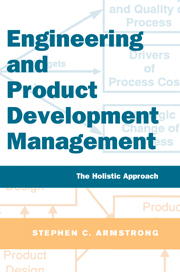Book contents
- Frontmatter
- Contents
- List of figures and tables
- Forewords
- Preface
- Acknowledgments
- Layout of book at a glance
- PART 1 UNDERSTANDING ENGINEERING PROCESS MANAGEMENT
- PART 2 APPLYING ENGINEERING PROCESSES TO PROGRAM MANAGEMENT
- 4 Roles and responsibilities
- 5 Approach to program and project management
- 6 An integrated team member's guide to performing a task
- 7 Program structuring and planning
- 8 Risk assessment
- 9 Program initiation and execution
- 10 Program reviews
- 11 Engineering change management and product data management
- PART 3 DEPLOYING ENGINEERING PROCESS MANAGEMENT
- PART 4 APPENDIXES
- Glossary
- References
- Index
11 - Engineering change management and product data management
Published online by Cambridge University Press: 05 April 2014
- Frontmatter
- Contents
- List of figures and tables
- Forewords
- Preface
- Acknowledgments
- Layout of book at a glance
- PART 1 UNDERSTANDING ENGINEERING PROCESS MANAGEMENT
- PART 2 APPLYING ENGINEERING PROCESSES TO PROGRAM MANAGEMENT
- 4 Roles and responsibilities
- 5 Approach to program and project management
- 6 An integrated team member's guide to performing a task
- 7 Program structuring and planning
- 8 Risk assessment
- 9 Program initiation and execution
- 10 Program reviews
- 11 Engineering change management and product data management
- PART 3 DEPLOYING ENGINEERING PROCESS MANAGEMENT
- PART 4 APPENDIXES
- Glossary
- References
- Index
Summary
One of the most challenging aspects of an advanced product engineering program, especially from the program manager's perspective, is managing change. Although most changes are ultimately for the good of the program, some may seem frivolous, while othersmaycause delays that raise questions as to just howmuch they actually benefit the program.
A clear plan for managing change on any program will make managing it significantly easier. This chapter suggests an approach to engineering change management, in addition to providing insight into the concept of change as it pertains to integrated product development. One of the hottest topics in engineering management is product data management or PDM. PDM is a software application used to help manage the engineering process and related data. We will cover the key concepts of PDM and the relationship to process management in this chapter.
WHAT IS ENGINEERING CHANGE?
Engineering change is the addition to, deletion from, or modification of a product during its design, development, or manufacture. It is a normal occurrence during the progress of a program, most often caused by an evolving business environment or an advance in product technology. Regardless of the reason behind it, a change can have a serious impact on a program's scope, cost, or schedule.
Changes are not synonymous with problems. A change is an alteration to the specification or design of a product, whereas a problem is a variance between the expected result and the observed result.
- Type
- Chapter
- Information
- Engineering and Product Development ManagementThe Holistic Approach, pp. 167 - 188Publisher: Cambridge University PressPrint publication year: 2001



